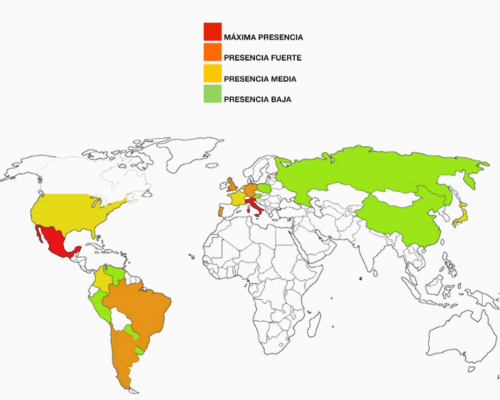Going global is a way to scale a startup, but the rush of growing in size can be compounded by the daunting step of starting to operate in other parts of the world.
Like everything in business, there’s no one-size-fits-all recipe for success; external and personal circumstances can influence and tip the scales one way or another when embarking on internationalization. However, there are basic concepts to keep in mind that can make this new phase a bit easier. Here are some tips for taking your startup global.
1. Make key decisions early on. From the beginning, it’s crucial to make decisions with internationalization in mind. Choosing a name that’s easily adaptable to different languages, with a focus on phonetics, is advisable.
In this regard, starting bilingual operations from the outset to facilitate the internationalization process is recommended, regardless of when it actually begins. These operations include having a multilingual website or conducting communications in several languages, among others, depending on the country where the startup seeks to go global.
2. International vision. To be international, you must aspire to it and think with this perspective in all aspects of the company, from administration to team management.
Startups that are oriented towards the international market from their inception are known as Born Globals. These businesses, whether from their foundation or shortly thereafter, launch into the global market. Those with a solid strategy quickly become key players for economic growth and revitalization. Notable examples of Born Globals include Softonic, a Spanish platform offering downloadable software, tutorials, and discussion forums; BuyVip, another Spanish company that sells clothing online and was acquired by Amazon; as well as the well-known eBay, Google, and Amazon.
When a startup considers internationalization, it’s very important to follow steps such as analyzing the current situation of the project, choosing the right time to do it, selecting the destination that best fits the startup’s needs, considering legal and fiscal matters, adapting the product to local needs and preferences, and defining an effective marketing and communication strategy.
3. Ask yourself what internationalizing means in your context. No two startups are the same; each comes from a completely different context. Therefore, when making this decision, you must first think about what activity the startup is involved in, what its market is like, and in what phase it is.
After answering these questions, think about where you are most interested in internationalizing (Spain, Latin America, the USA, etc.), and from these questions, develop your strategy step by step and study the country or market you want to enter. Consider the health of its innovative ecosystem, the startups operating within it, how much “competition” you will find, and what regulations will affect your business activity.
This way, you can establish an appropriate strategy. However, it’s not easy, and we can find examples of all kinds of startups that made good and not-so-good decisions when developing their internationalization strategy.
An interesting success story is Zyncro, founded in 2008, which specializes in providing social software solutions for businesses and has experienced rapid global expansion. With its headquarters in Barcelona, the company has established seven additional branches in various countries, including Mexico, Argentina, China, Japan, and Brazil, extending its operations to over 25 countries in total.
In contrast, there are cases where going global is not always the best option, as with Nonabox, a startup of baby products launched in 2012, which showed rapid growth from its inception, reaching over 5,000 subscribers and generating revenues above one million euros. However, in 2015, it faced difficulties that led its founders to sell the company to settle debts. Paradoxically, its rapid international expansion, often seen as key to a startup’s success, contributed significantly to its downfall.
Rome wasn’t built in a day, and there’s no need to land in that international market overnight. It’s better to step into internationalization gradually, solidifying each step.
4.Have the necessary structure. Entering the international market or opening a branch in another country requires a significant investment of time and money. Therefore, it’s essential to have the necessary structure to undertake these actions without failing.
The keys to forming a minimum structure for the internationalization process include having a board of directors and a management team. Boards of directors generally include internal directors, responsible for the day-to-day operations of the startup, and external directors who can provide impartial judgments. As for the management team, it necessarily includes a Chief Executive Officer (CEO), a Chief Financial Officer (CFO), a Chief Operations Officer (COO), and a Chief Marketing Officer (CMO).
Another key aspect is for your startup to have individuals with international experience, as this will facilitate adapting the entire company’s perspective to that goal. If they also come from the markets you want to enter, they will provide important information about their characteristics and functioning.
5. International investment. If, in addition to jumping to another market, you need investment for the operation and are thinking about seeking international investment,you need to make yourself known in this sector.
International events like VDS are a very useful tool for making connections and getting noticed. However, establishing these relationships is not easy; it’s one of the most challenging yet crucial aspects of developing a good internationalization strategy.
To tackle this task, consider the following aspects:
– Authenticity: It’s vital to find a personal way to approach investors, whether through a common contact or at an event where they are present.
– Focus on the product: The startup should not focus on the investor but on the project it is developing; this way, investors will come.
– Prepare company materials: Presenting a good image to those evaluating financing your project is key.
Regarding startup data on internationalization, international expansion has emerged as the main path for the growth of many startups. Keyprocom, a consulting firm, conducted an analysis on the international performance of 15 Spanish startups, finding that 33% have a presence in 4 to 6 different countries. A further 13% go beyond, establishing themselves in 7 to 9 different markets. However, 54% still operate only in their country of origin or in up to three countries.

As for market expansion preferences, there is a tilt towards Latin America due to linguistic similarity, and Europe due to cultural proximity, while only a small group ventures into Asia.

In terms of sectors, Spanish startups with a focus on internationalization belong mostly to the e-commerce sector (40%), followed by telecommunications and emerging technologies (20%), and in third place, the leisure and entertainment sector (13%). Most have a significant presence on global social networks like Facebook and Twitter, with profiles tailored to each market where they operate.

In summary, internationalizing a startup is more than a strategy; it’s a journey towards growth and innovation. This process, far from being linear, requires a global vision, adaptability, and a diverse team. The outlined keys do not guarantee success but offer a framework to face this challenge with greater assurance. In today’s business world, going international is not just an option but a necessity for those looking to transcend borders and make a difference.
With the right approach, internationalization can become the catalyst that propels startups to new horizons, marking the beginning of an exciting chapter full of opportunities in their success story.



